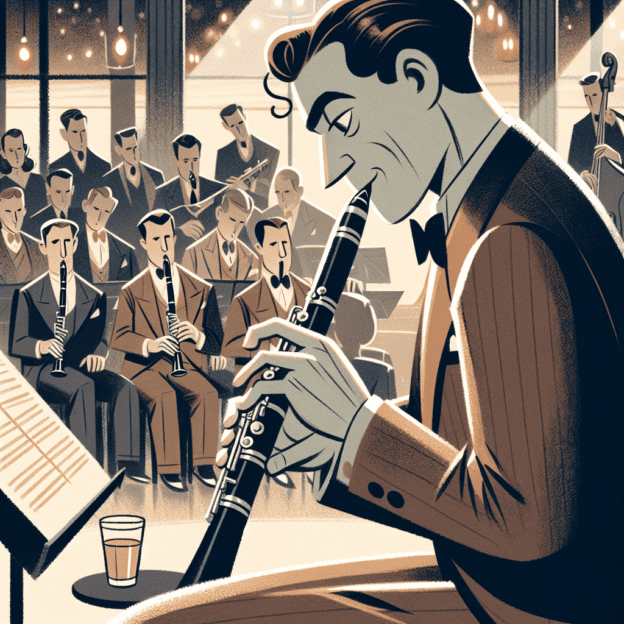Few names in jazz and big band music shine as brightly as Artie Shaw. A clarinetist who shaped the sound of an era, Shaw's touch mesmerized audiences. His famous rendition of ‘Begin the Beguine' stands out as a prime example. Released in 1938, this timeless classic continues to captivate music lovers today, showcasing Shaw's exceptional clarinet skills and his groundbreaking approach to music and orchestration.
The Man Behind the Clarinet
Arthur Jacob Arshawsky, better known as Artie Shaw, was born on May 23, 1910, in New York City. Shaw's love for music blossomed early, drawing him to the clarinet. The sounds of jazz giants like Louis Armstrong and Clarence Williams fueled his passion. Shaw's talents extended beyond the clarinet; he also excelled as a composer and bandleader.
Shaw's career took off when he formed his own bands in the late 1930s. He broke new ground by blending jazz and classical music in innovative ways. Shaw also pioneered the use of clarinet as a lead instrument in big bands, a move that set him apart from his contemporaries.
| Year | Milestone |
|---|---|
| 1910 | Artie Shaw born in New York City |
| Late 1930s | Forms his own bands, blending jazz and classical music |
| 1938 | Releases his famous rendition of ‘Begin the Beguine' |
The Story of ‘Begin the Beguine'
Musical genius Cole Porter introduced ‘Begin the Beguine' in 1935. However, it was Artie Shaw's version that launched the piece into stardom, cementing its place in the jazz repertoire. Shaw took Porter's composition and infused it with a vibrant swing, creating a piece filled with rich harmonies and captivating melodies that enchanted listeners.
Shaw's rendition showcases a flawless interplay between clarinet and orchestra. It opens with a soft, lilting melody that builds into a complex arrangement brimming with rhythmic intricacies and melodic improvisation. His subtle yet confident phrasing conveys deep emotion, transforming the piece into a profound musical experience.
Artie Shaw's Technique
To fully appreciate Shaw's genius in ‘Begin the Beguine,' let's explore the key elements of his distinctive playing style:
- Expressive Vibrato: Shaw's vibrato added warmth and depth to his sound. Clarinetists aiming to emulate his style should focus on smooth, controlled vibrato to achieve a fuller tone in performance.
- Dynamic Range: His masterful control of dynamics, alternating between soft, lyrical passages and more forceful phrases, created an engaging narrative throughout the piece. Practicing crescendos and decrescendos can greatly enhance expressive playing.
- Improvisational Flair: Shaw was renowned for his inventive improvisation. Aspiring clarinetists should practice improvising within familiar chord progressions and explore various melodic ideas while staying true to the music's narrative.
- Rhythmic Complexity: Shaw's ability to manipulate rhythm within phrases significantly contributed to the overall feel of his music. He excelled at syncopating his embellishments, creating a unique swing that defined his sound. Practicing various rhythmic patterns can help develop this skill.
Quick Tips for Clarinetists
- Practice long tones to develop a rich, solid tone
- Work on breath control to support extended phrases
- Experiment with different articulation techniques
- Listen to a variety of jazz recordings to broaden your musical vocabulary
A Lasting Legacy
Artie Shaw's influence extends far beyond his recordings. His approach to jazz clarinet playing has inspired countless artists, and he remains a key figure in the genre's development. By blending classical elements with jazz, Shaw opened doors for clarinetists to explore a wider range of styles and repertoires.
For jazz enthusiasts, especially clarinetists, Shaw's works offer both inspiration and a high standard of musical excellence. Shaw wasn't just a clarinet player; he was a musical storyteller who used his instrument to convey deep emotions and experiences.
How to Incorporate Shaw's Legacy into Your Playing
If you're a clarinetist looking to capture the spirit of Artie Shaw and infuse your playing with the magic of ‘Begin the Beguine', consider these tips:
- Listen Closely: Spend time with Shaw's version of ‘Begin the Beguine' and his other recordings. Pay attention to his phrasing, dynamics, and how he interacts with the ensemble.
- Practice Long Tones: Work on developing a rich, solid tone through long tone exercises. Learn to control your breath support and vibrato effectively.
- Record Yourself: Play along with recordings and make your own recordings. This will help you assess your playing, spot areas for improvement, and compare your sound to Artie Shaw's legendary performances.
- Get Feedback: Work with a teacher who understands jazz clarinet. They can provide valuable guidance and insights to help refine your technique and musicianship.
Remember, playing the clarinet isn't just about technical skill; it's about expressing your unique musical voice. As you develop your style, embrace Artie Shaw's legacy and explore the vast possibilities the clarinet offers.
Whether you're gearing up for a performance or just enjoying a jam session at home, channeling the spirit of the swing era can take your playing to new heights. Let the brilliance of Benny Goodman, Artie Shaw, and other clarinet legends inspire you on your musical journey!







